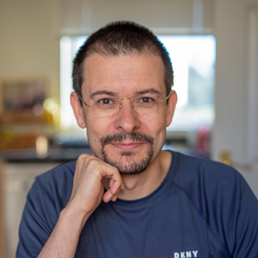
搜索网站、位置和人员

新闻与活动 活动信息
理学院专题学术讲座 | Prof. Ventsislav K. Valev:Nanophotonics Around the Clock for New Chiral Optical Effects and Quantum Optical Applications
时间
2021年1月20日(周三)
下午4:00-5:30
地点
西湖大学云栖校区4号楼613会议室,ZOOM直播
主持
西湖大学理学院Alexey Kavokin教授
受众
全体师生
分类
学术与研究
理学院专题学术讲座 | Prof. Ventsislav K. Valev:Nanophotonics Around the Clock for New Chiral Optical Effects and Quantum Optical Applications
时间:2021年1月20日(周三)下午4:00-5:30
Time:4:00-5:30 PM, Wed., Jan. 20th, 2021
主持人: 西湖大学理学院Alexey Kavokin教授
Host: Prof. Alexey Kavokin, Chair Professor of School of Science, Westlake University
地点:西湖大学云栖校区4号楼613会议室,ZOOM直播
Venue: Room 613, Building 4, Yunqi Campus, ZOOM webinar
线上:ZOOM直播(会议号:467 113 7478)
Online: ZOOM webinar (Meeting ID: 467 113 7478)
主讲嘉宾/Speaker:

Prof. Ventsislav K. Valev
Department of Physics, University of Bath
主讲人简介/Biography:
Ventsislav K. Valev is a Professor of Physics and Research Fellow of the Royal Society, in the Department of Physics, at the University of Bath. Prior to Bath, he was a Research Fellow in the Cavendish Laboratory, at the University of Cambridge. He received his PhD in 2006 from Radboud University Nijmegen, in the Netherlands. From 2006 to 2009, he was a Postdoctoral Researcher at KU Leuven, Belgium, and from 2009 to 2012 he was an FWO Research Fellow at the same university. His research group (http://www.valev.org/) builds laser experiments on novel materials, such as plasmonic nanostructures, metamaterials, 2D materials and quantum optical materials. He aims to discover new properties and to test theoretical predictions. The research focus is on the physics of photons, electrons and magnetism confined to tiny volumes of space – nanoparticles or 2D sheets. He seeks out new and useful intersections between classical electromagnetism and quantum mechanics. His research is both fundamental and applied, featuring the recent demonstration of a new physical effect that had been predicted 40 years ago and a joint project with the company Renishaw PLC, for whom his team is currently developing a prototype microscope.
讲座摘要/Abstract:
This seminar will focus on three absorbing lines of research into nanophotonics, representing three time scales of the physics involved. It will begin with the first experimental observation of a chiroptical effect that was predicted 40 years ago.1,2 Next, it will consider the smallest backjets (“nanojets”) ever created and will discuss how they can serve to assemble novel metamaterials.3,4 Finally, drawing inspiration from steampunk science fiction, it will illustrate how a vapour stabilization technique can greatly enhance quantum sensors.5
When light shines on metal nanoparticles (NPs), it is initially (fs timescale) absorbed by the electrons. These electrons give rise to “instantaneous” nonlinear optical processes, such as second harmonic (SH) generation, whereby two photons at the fundamental frequency w are converted into a single photon at twice that frequency W. This SH generation is promising for applications, based on frequency conversion (for laser manufacturing), on nonlinear optical characterization6,7 (e.g. microscopy) and on metasurfaces (for ultrathin telecom components). Our team recently demonstrated that in chiral metal NPs (those that lack mirror symmetry) the intensity of light, scattered at the SH frequency, is proportional to the chirality, see Fig. 1. This effect was predicted 40 years ago, it is extremely sensitive and it enabled the first chiral optical characterization of a single nanoparticle.8

Fig. 1 Different SH scattering intensity depending on the chirality of the nanoparticles (NPs).
At the ps timescale following illumination, the energy of electrons transfers to the NP lattice. The transfer gives rise to lattice vibrations (phonons) that are promising for applications in photoacoustic imaging and in the three branches of nano metalworking: forming, cutting and joining. We will consider examples of all three, focusing on the formation of nanojets in the electromagnetic hotspots of gold NPs and on joining (welding) gold NPs together in continuous strings. Nano metalworking is an exciting, emerging field that is largely unexplored.
At the ns timescale following illumination, the energy transfers from the NP's lattice to its environment, in the form of heat. Such heating processes find applications in nanorobotics, in cancer treatment, in heat-assisted magnetic recording, in steam/vapor generation and now in quantum sensors. Indeed, numerous quantum technologies are enabled by alkali metal vapors: atomic clocks, ultra-fine frequency lasers, atomic traps, optically pumped magnetometers, etc. The metal atoms are kept in a vacuum, within containers made of metal or glass. Unfortunately, upon colliding with the container walls, the atoms lose their quantum states or condense. Current methods to address these problems are slow, costly and impractical to scale up. We developed a gold NP-based coating, whereby the NPs serve as tiny heating elements on the interior of the container walls, which prevents the atoms from sticking to them. Our technology offers 1,000 times faser control of the atomic vapor pressure and could enable wearable helmets for human magnetoencephalography.
References
1. Phys Rev. X 9, 011024 (2019).
2. J. Chem. Phys. 70, 1027 (1979).
3. Adv. Mater. 24, OP29-OP35 (2012).
4. Nat. Commun. 5, 4568 (2014).
5. Nat. Commun. 10, 2328 (2019).
6. ACS Nano 13, 3896–3909 (2019).
7. Nano Lett. 19, 165-172 (2019).
8. Nano Lett. 20, 5792–5798(2020)
讲座联系人/Contact: 理学院,雷老师,leirong@westlake.edu.cn

















